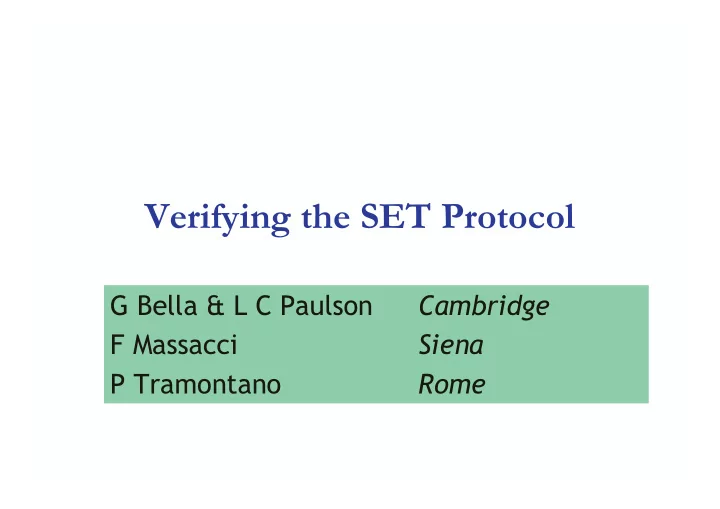

Verifying the SET Protocol G Bella & L C Paulson Cambridge F Massacci Siena P Tramontano Rome
Inductive Protocol Verification • Define system’s operational semantics • Include honest parties and an attacker • Model each protocol step in an inductive definition • Prove security properties by induction • Mechanize using Isabelle/HOL 2 Lawrence C Paulson
Can Big Protocols Be Verified? • Can verify some real protocols: – Kerberos IV – TLS (the new version of SSL) – APM’s recursive protocol • Other verification methods available: – Model-checking (Lowe) – NRL Protocol Analyzer (Meadows) 3 Lawrence C Paulson
Growth in Protocol Complexity 6 pages • Needham-Schroeder (1978): 80 pages • TLS: • SET: 5 main sub-protocols, 3 manuals, nearly 1000 pages Why so big? 4 Lawrence C Paulson
Internet Shopping with SSL Credit card details SSL Curses! Can’t get that number! 5 Lawrence C Paulson
Do We Trust the Merchant? Credit card details?? Now I can buy that software! SSL 6 Lawrence C Paulson
Do We Trust the Customer? Fake card details Send MS Office, charge to my SSL card... 7 Lawrence C Paulson
Basic Ideas of SET • Legitimate Cardholders and Merchants receive electronic credentials • Merchants don’t see credit card numbers (usually!) • Payment is made via the parties’ banks • Both sides are protected from fraud 8 Lawrence C Paulson
SET Participants • Issuer = cardholder’s bank • Acquirer = merchant’s bank • Payment gateway pays the merchant • Certificate authority (CA) issues electronic credentials • Trust hierarchy: top CAs certify others 9 Lawrence C Paulson
Internet Shopping with SET purchase details SET Her bank His bank 10 Lawrence C Paulson
SET Cryptographic Primitives • Hashing, to make message digests • Digital signatures • Public-key encryption • Symmetric-key encryption: session keys • Digital envelopes involving all of these! • Deep nesting of crypto functions 11 Lawrence C Paulson
The 5 Sub-Protocols of SET � � • Cardholder registration � � � � • Merchant registration � � • Purchase request • Payment authorization • Payment capture � verified! � � � 12 Lawrence C Paulson
CARDHOLDER REGISTRATION CERTIFICATE CARDHOLDER AUTHORITY (CA) INITIATE COMPUTER PROCESS REQUEST CARDHOLDER CERTIFICATE INITIATES AUTHORITY REGISTRATION SENDS INITIATE RESPONSE RESPONSE CARDHOLDER RECEIVES RESPONSE REGISTRATION AND FORM REQUEST REQUESTS REGISTRATION CERTIFICATE FORM AUTHORITY PROCESSES REQUEST AND REGISTRATION SENDS FORM REGISTRATION FORM CARDHOLDER RECEIVES REGISTRATION FORM CARDHOLDER AND CERTIFICATE REQUEST REQUESTS CERTIFICATE CERTIFICATE � Let’s look at AUTHORITY � PROCESSES REQUEST AND this message CARDHOLDER CREATES CARDHOLDER CERTIFICATE CERTIFICATE RECEIVES CERTIFICATE 13 Lawrence C Paulson
Message 5 in Isabelle [ evs5 ∈ set_cr; C = Cardholder k; [ Nonce NC3 / ∈ used evs5; Nonce CardSecret / ∈ used evs5; NC3 � = CardSecret; Key KC2 / ∈ used evs5; KC2 ∈ symKeys; Key KC3 / ∈ used evs5; KC3 ∈ symKeys; KC2 � = KC3; Gets C ... ∈ set evs5; Says C (CA i) ... ∈ set evs5 ] ] ⇒ Says C (CA i) = | Crypt KC3 { | Agent C, Nonce NC3, Key KC2, Key cardSK, { Crypt (invKey cardSK) (Hash { | Agent C, Nonce NC3, Key KC2, Key cardSK, Pan(pan C), Nonce CardSecret | } ) | } , Crypt EKi { | Key KC3, Pan (pan C), Nonce CardSecret | }| } # evs5 ∈ set_cr 14 Lawrence C Paulson
What Did That Mean? • Cardholder had asked to register a PAN (primary account number) • Cardholder has received the CA’s reply • Cardholder sends a digital envelope: – A public signing key, cardSK – A message, signed using the private key – Two session keys (one for the CA’s reply) – A secret number, CardSecret 15 Lawrence C Paulson
Secrecy of the Card Number • Intuitively obvious: PAN is always hashed or encrypted • Huge case-splits caused by nested encryptions • Two lemmas: – Session keys never encrypt PANs – Session keys never encrypt private keys 16 Lawrence C Paulson
Secrecy of Session Keys • Three keys, created for digital envelopes • Dependency: one key protects another • Main theorem on this dependency relation • Generalizes an approach used for simpler protocols (Yahalom) 17 Lawrence C Paulson
Secrecy of Nonces • Secret numbers exchanged to generate Cardholder’s password • Protected using those session keys • Similar to the proofs for keys • Main theorem about the Key/Nonce dependency relationship 18 Lawrence C Paulson
The Purchase Phase! 19 Lawrence C Paulson
Novel Aspects of SET Purchase 3-way agreement: with partial knowledge! • Cardholder shares Order Information only with Merchant • Cardholder shares Payment Information only with Payment Gateway • Cardholder signs hashes of OI, PI • Non-repudiation: all parties sign messages 20 Lawrence C Paulson
Complications in SET Purchase • Massive redundancy: exponential blow-ups • Insufficient redundancy (no explicitness), requiring toil to prove trivial facts • Two message flows: signed and unsigned • Many digital envelopes • No clear goals: What should I prove?? 21 Lawrence C Paulson
Conclusions • Proofs are big, but not too big! • Can prove secrecy for several keys and nonces, with dependency chains • Can handle digital envelopes • Merchant registration verified similarly— Purchase & Payment phases too! 22 Lawrence C Paulson
Recommend
More recommend